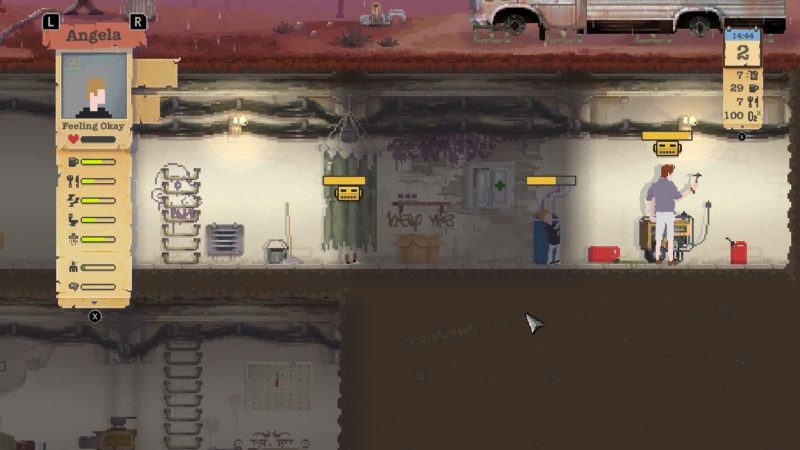
Sheltered, by publisher Team17, is a survival game. In it, you direct a group of survivors in a fallout shelter to see how many days they can survive (with your direction) in an apocalyptic wasteland.
The shelter comes equipped with a hazmat suit locker, a set of doors, a water filter, an oxygen filter, and a generator. The water filter and oxygen filter—along with various other things that can be built in the shelter—rely on power from the generator. The generator can be refueled either by adding fuel to it or by throwing an unneeded item into the incinerator (provided you have built one). The oxygen filter will continue to give you oxygen as long as it is repaired when it breaks down. The water filter will store the water you find and gather water during rainstorms.
Your four main resources are water, food, fuel, and oxygen. Oxygen will take care of itself as long as you keep the oxygen filter operational and you don’t exceed the occupancy limit—something which can be upgraded if you have the right materials. Water can be collected when it rains. In fact I found rain to be my main source of income for water. Food can be gathered by setting up traps. To gain fuel to power your shelter’s generator, you need to either send someone out to the wasteland to look for fuel or build an incinerator to turn unneeded items into fuel.

All characters under your care have needs that need to be met. These needs are hunger, thirst, stress/trauma, bladder, and cleanliness. As you can guess, only the first two are fatal, although bladder and cleanliness can contribute to stress/trauma if left unchecked. If a character suffers from to high stress/trauma, they have a chance of turning psychotic and attacking the other characters in the shelter. Bladder and cleanliness can be taken care of by crafting make-shift toilets and showers, although be warned that these drain from your water supply. Characters can either be directly commanded by you to fulfill their various needs or they can be set to take care of their needs themselves provided the supplies and structures to do so are available.
In the standard survival mode for the game, your shelter comes equipped with a radio. The radio can be used to listen to radio frequencies, to attempt to contact other survivors, or to set up an expedition into the wasteland.

When setting up an expedition, you first select up to two characters in the shelter and equip them with any weapons or items you have stumbled across. You then need to pick a destination for them to head to, although the further away the destination is from the shelter, the more water it will cost. This resulted in numerous cases where I couldn’t venture out into the wasteland to gather supplies because I had ran out of water and was relying on luck or a rainstorm to save my characters before they died of thirst.
While the main things you want to look out for when scavenging the wasteland are food, water, and fuel; there are other things you can find. You can find: 1) materials that can be used to make bandages and medicine to deal with wounds and illnesses; 2) weapons and ammo; and 3)other survivors who either want to trade with you, become a part of your group, or attack you on sight. While out, you also have the option of bullying someone before interacting with them to steal their resources.

Things like schools, churches, and hospitals are labeled on the map. As you might guess, you are more likely to find resources or materials at the locations that are normally associated with those locations. For example, a hospital is more likely to contain medicine than a school. And before you get any ideas about memorizing the map for the best loot locations, the map is randomized each time you start a new game.
This game also features a crafting system. You can create things such as water tanks to store additional water, freezers to store meat, crates to increase the shelter’s inventory space, traps to catch wildlife, traps to kill invaders, and specialized crafting stations for things like gun ammo. Some structures in the base also have the option of being upgraded. As you can probably guess, building/upgrading things costs materials. You can either search for these materials in the wasteland or get them from survivors that offer to trade with you (although each survivor has different items available for trade).

Using the radio to attempt to contact other survivors has one of two results. It either begins attracting people to your shelter who want to trade or it attracts bandits. In the case of the latter, they will attack the door to your shelter’s entrance and either attack your group or raid some of the supplies from your base. Luckily, you can craft hiding spots for your characters and traps to potentially kill the invaders—though make sure to read the item description of a trap before building it so you know whether it is a trap against invaders or a trap to catch meat as the game treats the two as separate things (a trap for wildlife does nothing to invaders and a trap against invaders doesn’t help in hunting wildlife). If one of the raiders touches one of your characters, you will be asked whether or not you want another character to assist them. Then, you outfit the character(s) with items, weapons, ammo, and/or bullet-proof vests, provided you have found/built some. Then a battle begins between your character(s) and all the raiders.

Battles in the game, whether against hostile survivors in the wasteland or raiders in your base, take place in a turn-based format. Each character in the battle chooses an action to perform, or in the case of your characters, you choose an action for them to perform and then the character performs that action before allowing the next character to take their turn. If a character has a bullet-proof vest equipped, it will block a certain number of gunshots before falling apart. It also lowers the damage taken from melee attacks while it is still intact, and melee attacks don’t lower the durability of bullet-proof vests. You have the option of either performing a melee attack, performing a ranged attack, attempting to disarm an opponent wielding a weapon, attempting to subdue a weak opponent, skipping your turn to defend and attempt to lower damage received, or use an item to heal damage or a status condition. All attacks have a chance to cause bleeding, a condition that slowly drains the health of the victim.

Aside from the main game, there are also two scenarios you can play through. These scenarios impose additional rules and conditions on you along with giving you a possible condition for victory (as opposed to the main game where you try to see how long you can last before everyone dies).
Overall, while I had trouble managing my resources—particularly my water—I thought Sheltered was well-made. As such, I think a fair rating for it is 7/10
Check Out the Sheltered Nintendo Switch Video:
Sheltered is available for Nintendo Switch, Xbox One, PlayStation 4, and PC via Steam.
Nintendo Switch Review
I am a recent Computer Science/Game Development Programming Chapman University Graduate. I am a life long enthusiast of computer/video gaming and my favorite game genres are adventure, choice-driven stories, fighting, and racing. My favorite game/movie series include but aren't limited to 'Legend of Zelda'; 'Dragon Age'; 'Persona'; 'Sonic the Hedgehog'; 'Mario'; 'Metroid' ;'Megaman'; 'Naruto'; 'Batman'; 'Spiderman'; 'Star Wars'; and 'Star Trek.'





More Stories
Nintendo Download Update (Dec. 4, 2025) – Metroid Prime 4: Beyond Now Available!
Red Dead Redemption and Undead Nightmare Available Now on Netflix, PS5, Xbox Series X|S, iOS, Android, and Nintendo Switch 2
SLEEP AWAKE Review for PlayStation 5